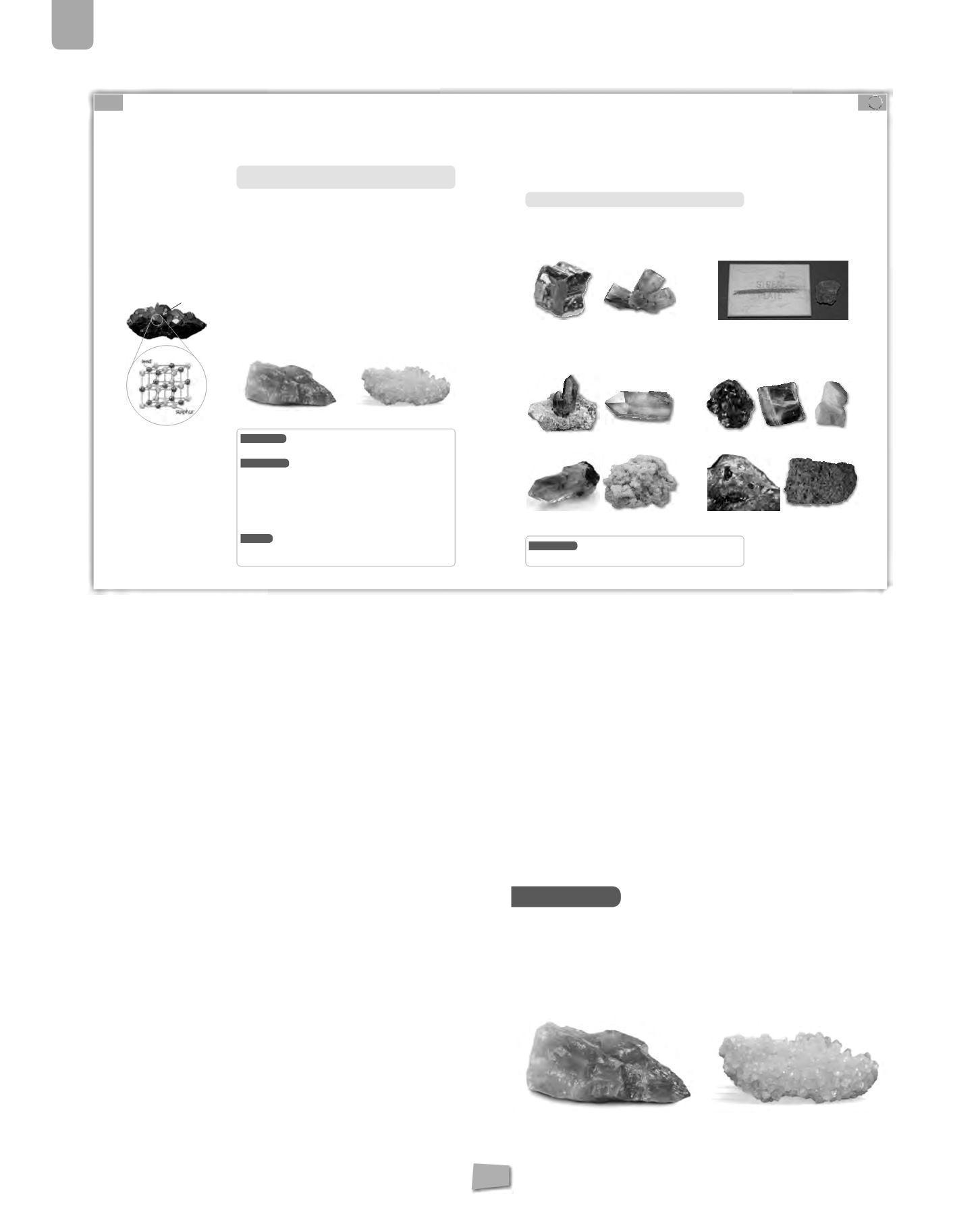
3
The Geosphere
108
2.
Minerals
Ask the students: How do you differentiate a mineral from a rock?
At this stage, students tend to mix up the concepts of mineral and
rock. Highlight that minerals are the materials that make up rocks.
Show them a granite rock. Explain that granite is a rock but the
different colors on it are the minerals that actually formed it. Ask
them again the meaning of mineral and rock and make sure they
all understand the difference between these two concepts.
When you talk about the definite chemical composition, emphasise
that there are some minerals that are formed by only one single
chemical element such as sulphur, gold and silver. These are called
native minerals. Students should now do activities 4 to 10. Below
you will find suggestions for each activity.
4. Ask students to do this on their own and then compare
answers.
5. Ask students to compare the two images in groups and
then write the answers on the board.
6. Do this as a whole group activity.
7. Write various possible answers on the board and ask
students to choose the correct one.
8. Ask students to do this quickly in groups of three and elicit
answers.
9. Ask students to do this in pairs and then to compare their
answers with
another pair before asking a spokesperson
from each group to answer.
10. Ask students to do this individually, then pick up a few
of their notebooks and randomly read the definitions out
loud. Students can vote on the most accurate definition.
Include the answer as one of the possibilities. The diagram
in the margin on page 50 should help them understand.
2.1.
Physical properties of minerals
Ask students
How can we distinguish one mineral from the
other?
Explain that the physical properties of minerals help us to
distinguish one from the other. Tell them to read the text and look
at the images. Then ask them to do question 11.
11. Do this activity with the whole class, then write the answer
on the board and ask students to copy it.
Answer key
Remember
4.
Write a list of the characteristics of minerals in your
notebook.
Minerals are solid, inorganic, natural minerals. They have a
definite chemical composition and usually have a crystalline
structure.
50
51
3. Thegeosphere
3
+
www
2.
MINERALS
Minerals and rocks form part of the Earth’s crust. Since ancient times, humans
have used minerals obtained from the Earth.
In order to understand the definition of minerals we will analyse the description
term by term.
❚
Minerals are
solid substances
. They cannot be liquid or gaseous at room
temperature. This is why mercury is not considered a mineral.
❚
They are
inorganic
. They have not been produced by living things, unlike pearls,
shells or amber.
❚
Theyarenatural.Thismeans theyhavenotbeenmadebyhumans, likeplasticorglass.
❚
They have a
definite chemical composition
. They are composed of chemical
elements that are always combined in the same proportion to create the same
mineral. For example, galena, is a mineral formed by two chemical elements:
sulphur and lead.
❚
They have a
crystalline structure
. This means that the particles are arranged to
form a geometric structure that is repeated constantly. For example, the atoms
of galena are structured to form a cubic shape.
If the arrangement of the mineral particles are visible, we call this a
crystal
.
Crystals need enough time and space to form. In a crystal we can identify the
edges, flat faces and the vertices of its geometrical shape.
Minerals
are solid, inorganic, natural materials. They have a definite chemical
composition and usually have a crystalline structure.
2.1.
Physical properties of minerals
Innature therearemore than4000knownminerals.Wecan identifysomeminerals
by studying theirphysicalproperties,withoutanalysing theirchemicalcomposition.
Physical properties are classified into optical, mechanical and magnetic.
2.1.1.
Optical properties
Crystallisationofminerals
Crystalline structureofminerals
galena
Understand
11.
Explain thedifferencebetween the colourand the streakofamineral.
Remember
4.
Write a list of the characteristics of minerals in your notebook.
Understand
5.
Look at the two pink quartz roses above. Explain which one had more
space and time to form.
6.
Look at the photo of galena above. Can you say that it is a crystal?
7.
Explain why amber is not a mineral.
8.
Would you classify factory-made diamonds as minerals?
9.
Is water a mineral? Explain your answer.
Create
10.
Look for thedefinitionof
mineraloide
.Decide if theglass inawindow
is a mineral or a mineraloide and explain your answer.
A mineral’s
optical properties
relate to how a mineral reacts to light.
❚
Habit
: some minerals have very characteristic shapes
that reflect their crystalline structure. For example,
pyrite has cubic shapes and aragonite has hexagonal
shapes.
❚
Streak
: is the colour of the powder produced when a
mineral is scratched.Thecolourof the streakdoesnot
have tobe the sameas themineral.Forexample, solid
quartz can be many different colours, but its streak is
always white.
Pyrite
Aragonite
Galena and its streak
❚
Colour
: some minerals have a very characteristic
colour. Galena is rusty grey and sulphur is bright
yellow. Other minerals, like quartz, can be found in
different colours, as seen in the images below.
❚
Lustre
: describes how the mineral reflects light. It can
be metallic if it shines like metals, glassy if it is like
glass, pearly, if it shines like a pearl, diamond-like, or
dull if it doesn’t shine.
Bluequartz
Transparentquartz
Metalic:magnetite
Glassy: fluorite
Pearly:gypsum
Pinkquartz
Sulphur
Diamond-like: rutile
Dull: limonite


